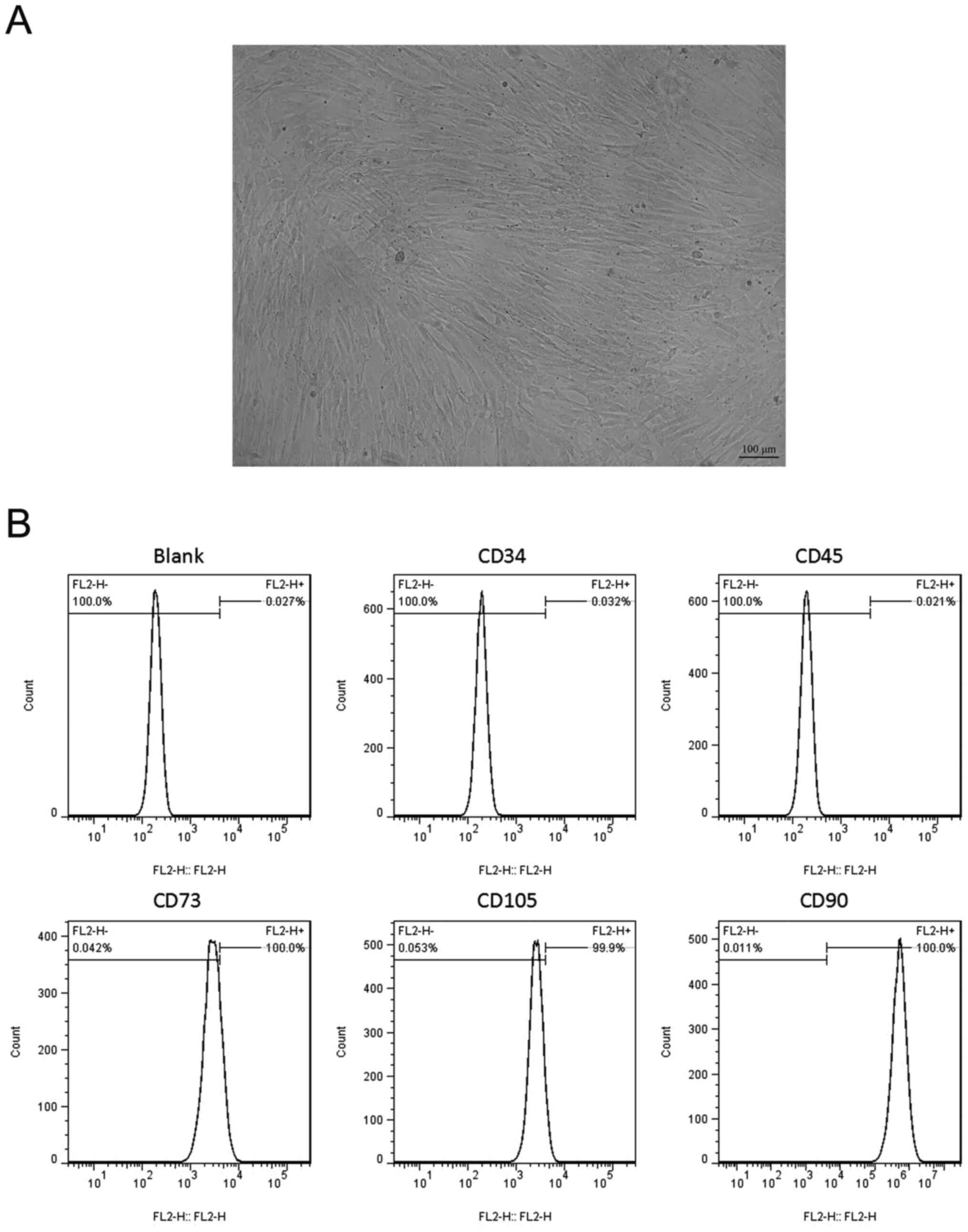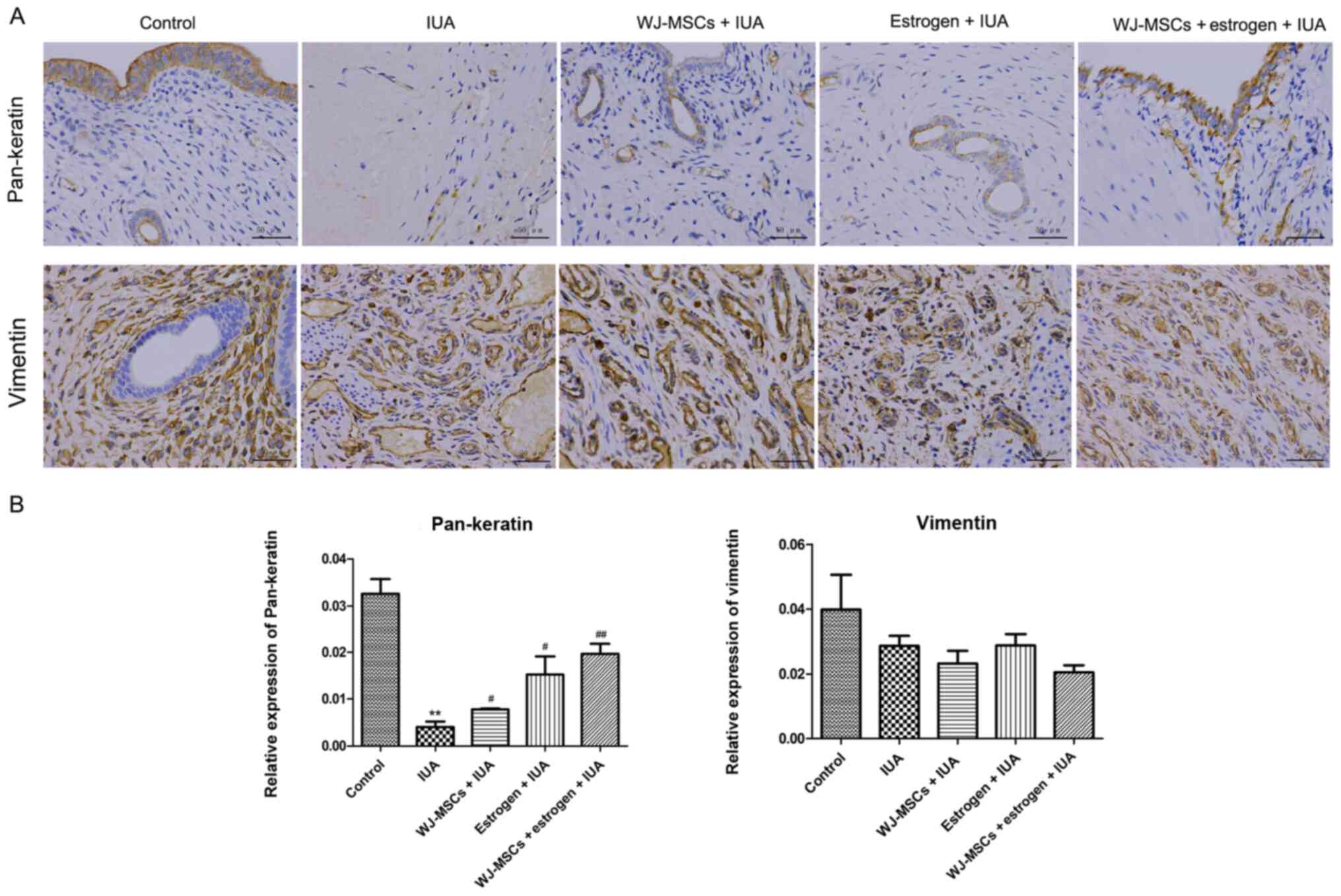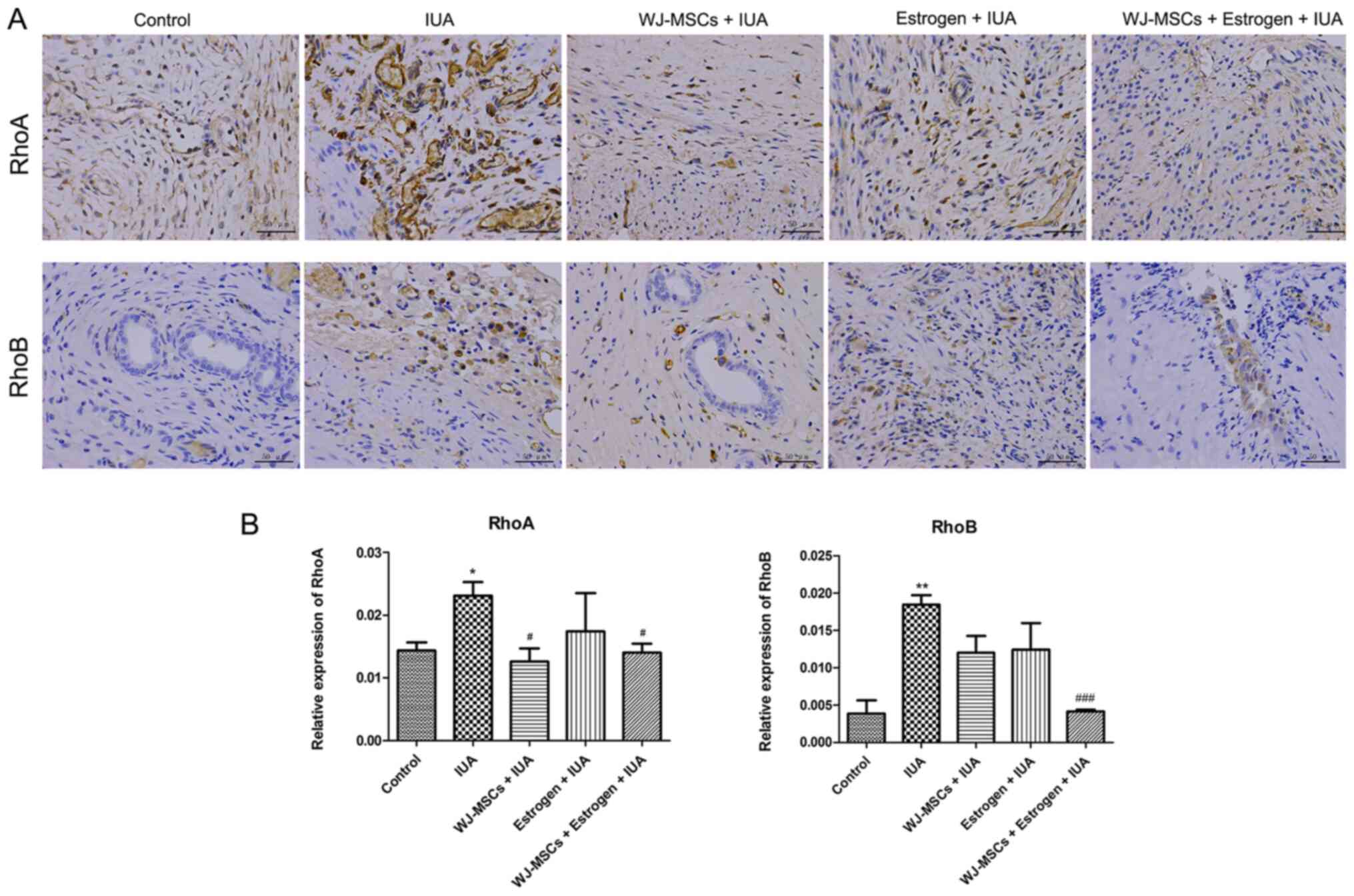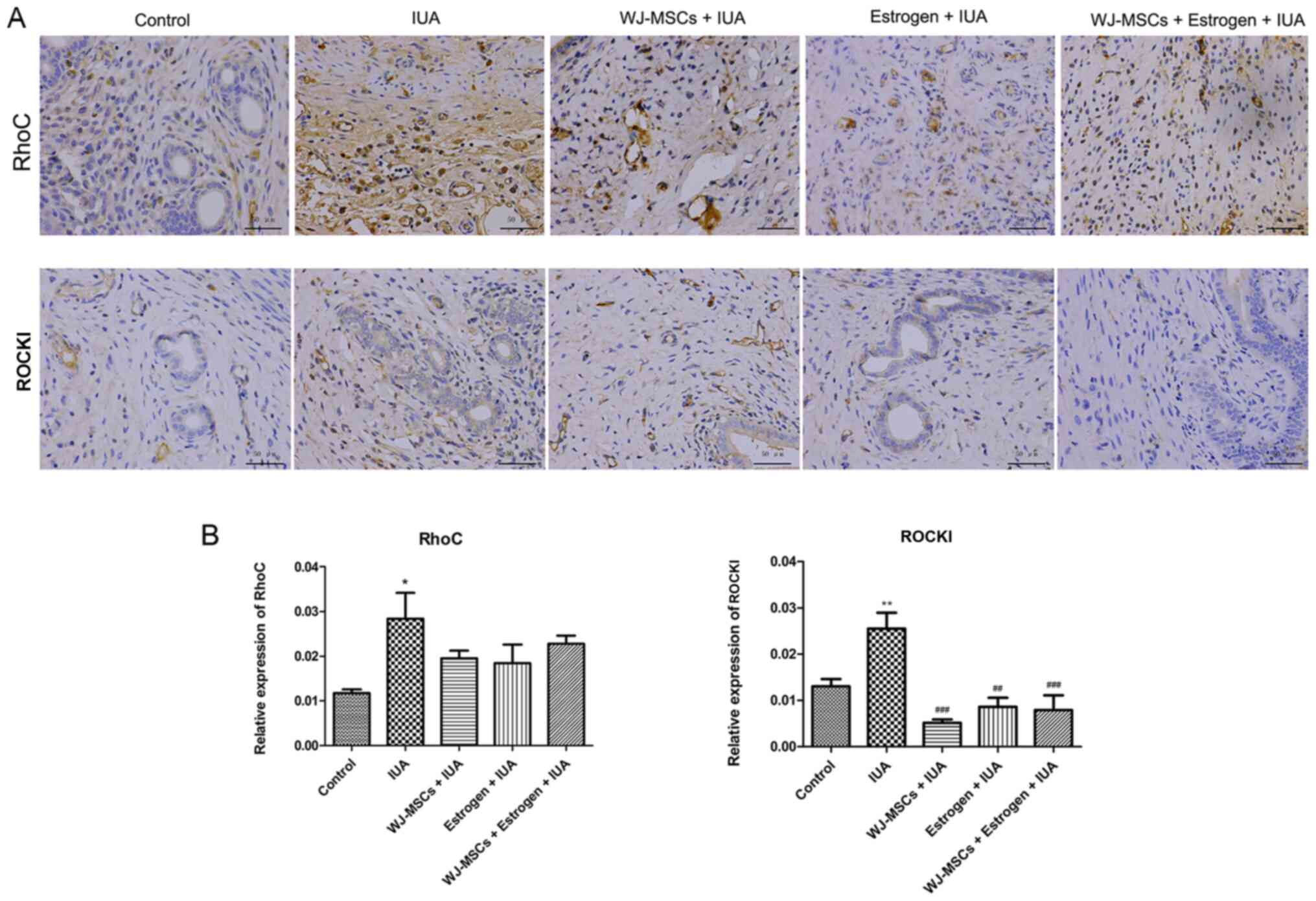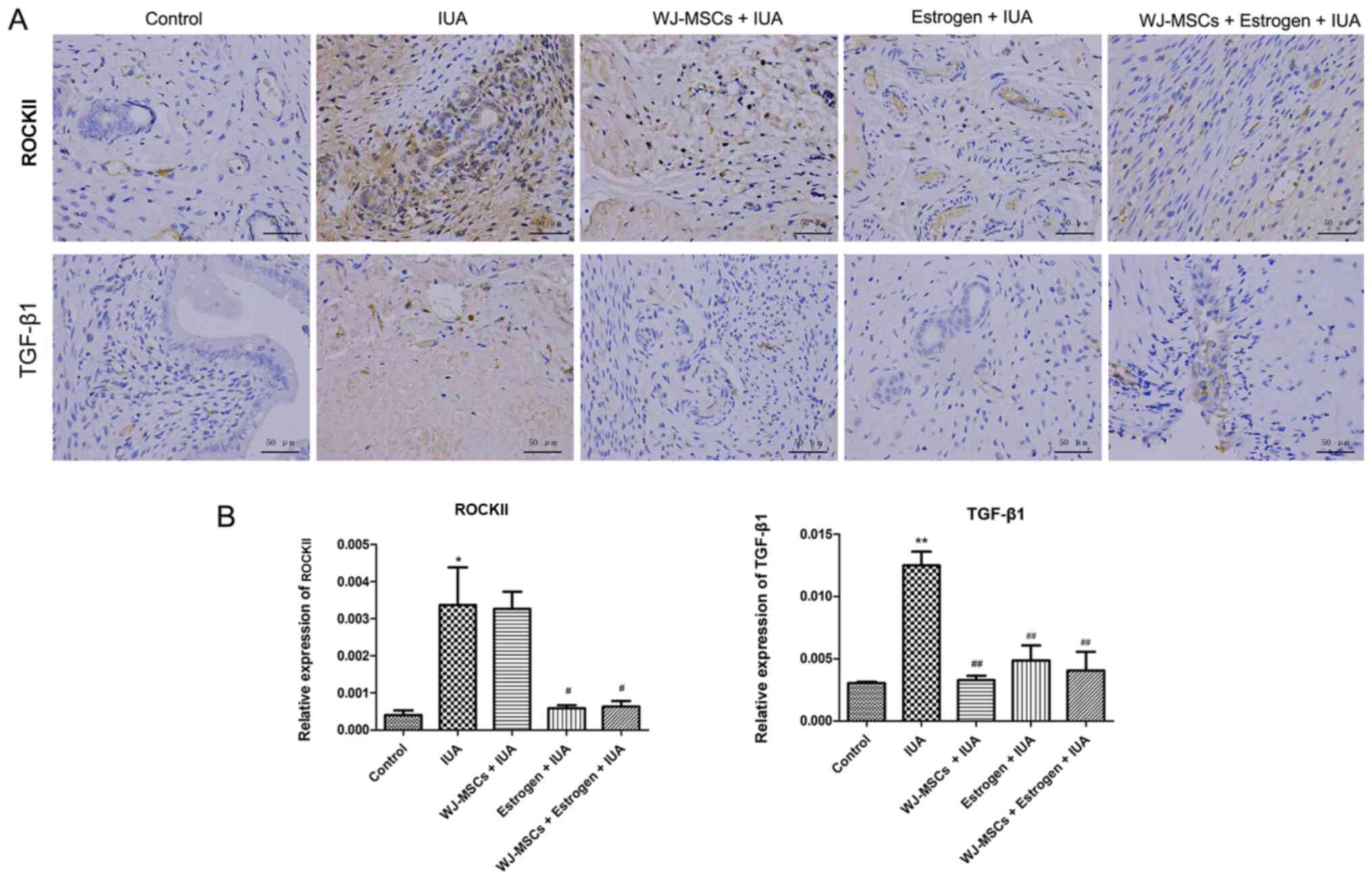Introduction
Intrauterine adhesion (IUA), also named Asherman's
syndrome, is characterized by endometrial fibrosis and IUAs with
partial or complete uterine cavity occlusion (1). IUA generally occurs following
endometrial damage, non-pregnant uterine tract injury, miscarriage
and infection (2). Hypomenorrhea,
pelvic pain and infertility are the main clinical manifestations in
patients with IUA (3). The primary
objective of IUA treatment is to restore endometrial regeneration
and the shape of the uterine cavity, and prevent recurrence of
adhesion. Although hysteroscopic adhesiolysis is a standard therapy
for IUA treatment, numerous adjuvant therapies are required due to
the varying degrees of IUA (4).
Estrogen is a commonly used hormone therapy for IUA,
which promotes endometrial growth during preoperative treatment and
enhances endometrial regeneration during postoperative treatment
(5). However, estrogen therapy as
an adjuvant treatment commonly needs to be combined with other
therapies to obtain maximal outcomes. In recent years, mesenchymal
stem cell (MSC) or endometrial stem cell transplant into the
uterine cavity of patients with IUA or female rats has been
reported to promote endometrial regeneration (6), which may be due to the potential
differentiative capacities of the stem cells (7).
Human Wharton's jelly MSCs (WJ-MSCs) isolated from
the umbilical cord possess strong self-renewal and proliferative
activities, are hypo-immunogenic and non-tumorigenic, and are not
associated with ethical controversy (8). Commonly, WJ-MSCs are discriminated by
the detection of positive cell makers, such as CD44 and CD105
(matrix receptors), CD73 glycoprotein and CD90 (Thy1), and the lack
of hematopoietic lineage markers (CD34 and CD45) (9). WJ-MSCs, which share the natural homing
capabilities of MSCs, demonstrate a promising cell therapy in
future clinical applications for degenerative diseases (9). It was previously reported that WJ-MSC
transplantation prevented early pregnancy loss in a rat model of
spontaneous abortion (10).
However, to the best of our knowledge, research regarding the
application of WJ-MSCs to treat IUA is rarely reported.
Endometrial fibrosis and endometrial regeneration
disorders are key to the formation of IUA (11). Studies have reported that
epithelial-mesenchymal transition is one possible pathogenic factor
of IUA, and this process was associated with epithelial cell
regeneration disorder following progression of endometrial basal
layer injury to endometrial fibrosis (12,13).
Transforming growth factor (TGF)-β 1 is the most important
fiber-forming cytokine, and is also an upstream signaling factor
for Rho, which is one of the most important members of the Rho
GTPase family, which includes A, B and C isoforms (14). Rho-associated coiled-coil-containing
protein kinase (ROCK) is the most studied downstream effector
molecule of Rho (15). The Rho/ROCK
signaling pathway mediated by TGF-β1 could induce fibrotic lesions
(16). Keratin and vimentin are
members of the intermediate filament family and are implicated in
regulating a variety of cellular functions, especially in
epithelial cells (17,18). Considering all these findings, the
objective of the present study was to investigate the therapeutic
effects of estrogen and WJ-MSCs, separately or as a combined
therapy, for IUA, and to further explore whether a TGF-β1-mediated
Rho/ROCK pathway can function in IUA.
Materials and methods
Animals
Sprague-Dawley female rats (age, 9 weeks; weight
180–220 g) were purchased from Shanghai SLAC Laboratory Animal Co.,
Ltd. All rats were housed under specific pathogen-free conditions
with a 12-h day/night cycle, and ad libitum access to food
and water. All animals were maintained at a temperature of 22±1°C
and humidity of 55±5%. All the experimental operations for rats
conformed to the Guide for the Care and Use of Laboratory Animals
(19). This study was approved by
the ethics committee of the People's Hospital of Wuhan University.
A total of 55 rats were used, of which five rats were used in the
preliminary experiments, and 50 rats were used in the current
study.
WJ-MSCs culture and
identification
WJ-MSCs were acquired from Professor Chen Yantian
(20) (Cell Culture and Bioprocess
Engineering Lab, School of Pharmacy, Shanghai Jiao Tong
University). The cells were cultured in complete medium, comprising
α-minimum essential medium (cat. no. 12571063; Gibco; Thermo Fisher
Scientific, Inc.), 10% fetal bovine serum (FBS; cat. no. 16140071;
Gibco; Thermo Fisher Scientific, Inc.) and 1%
penicillin/streptomycin (cat. no. B540734; Sangon Biotech Co.,
Ltd.), and maintained at 37°C in a humidified atmosphere of 95% air
and 5% CO2. The phenotype of WJ-MSCs was determined by
flow cytometry (FACSCalibur; BD Biosciences). Flow cytometric
analysis was conducted with fluorochrome-conjugated antibodies
against human CD73, CD90, CD105, CD34 and CD43. Briefly, the cells
in the logarithmic phase were suspended in Hank's Balanced Salt
Solution (HBSS) supplemented with 2% FBS, and the cell density was
adjusted to 1×107 cells/ml. Then, cells (100 µl) were transferred
to a 1.5-ml Eppendorf tube with antibodies against CD73 (cat. no.
550257; BD Biosciences), CD90 (cat. no. 555596; BD Biosciences),
CD105 (cat. no. 560839; BD Biosciences), CD34 (cat. no. 550761; BD
Biosciences) and CD45 (cat. no. 555483; BD Biosciences) (20 µl),
and incubated on ice for 30 min. After washing three times, cells
were transferred to a flow tube and resuspended in HBSS for flow
cytometry on a BD FACSCalibur flow cytometer (BD Biosciences). The
data were analyzed using FlowJo 10 software (FlowJo LLC).
Establishment of a rat model of
IUA
The IUA rat model was constructed using the ethanol
damage method (21). Briefly, rats
were anesthetized with 1% pentobarbital sodium (30 mg/kg) through
intraperitoneal injection, and the abdominal wall and cavity was
surgically opened to expose the uterus under sterile conditions.
The upper and lower ends of the bilateral uterine walls were
clamped with bulldog clamps and 0.5 ml 95% ethanol was injected
into the bottom of the uterine wall. After maintaining it for 3
min, saline solution was injected into the uterine wall twice for
washing. In addition, saline solution was used to replace the
ethanol injection in the control group following the same
operation. Finally, the abdominal cavity and wall were closed in
layers, and 80,000 U/100 mg penicillin (North China Pharmaceutical
Co., Ltd) was intramuscularly injected to prevent infection 3 days
after the operation. After 14 days, IUA was confirmed by evaluating
the histopathological changes in the uterine specimens using
hematoxylin and eosin (H&E) staining.
Experimental protocol for IUA
treatment
A total of 50 Sprague Dawley female rats were used
in the present study. The rats were randomly divided into five
groups (n=10 rats/group): Control group; IUA model group; WJ-MSCs
treatment group; estrogen treatment group; and WJ-MSCs + estrogen
treatment group. IUA model rats were prepared as aforementioned. In
the WJ-MSCs treatment group, 2 weeks after IUA model construction,
a relaparotomy was performed and 2×106 WJ-MSCs at middle
passage (P3-P7) were injected into the left uterine horn of IUA
rats. In total, the intraperitoneal injections of WJ-MSCs were
conducted three times at 5-day intervals. In the estrogen treatment
group, 2 weeks after model rats were successfully prepared, IUA
rats received 0.2 mg/kg estrogen (cat. no. E8875; Sigma-Aldrich;
Merck KGaA) through intragastric administration, once every 2 days
for 8 weeks. In the WJ-MSCs + estrogen treatment group, 2 weeks
after IUA model construction, model rats were treated with WJ-MSCs
injection and estrogen intragastric administration together. During
the period, the health and behavior of rats were observed every
other day. After 8 weeks of intervention, the rats were
anesthetized with 1% pentobarbital sodium (30 mg/kg) by
intraperitoneal injection prior to sacrifice by decapitation
(animal death was verified by observing no behavior after 5 min),
and the uterine tissues of the experimental rats were resected.
H&E staining
The pathology of the specimens in each group was
evaluated by H&E staining under an inverted microscope (IX73;
×40 magnification; Olympus Corporation). In brief, uterine tissues
were fixed at room temperature for 48 h in 10% formalin and
dehydrated in ascending concentrations of ethanol: 70% for 3 h, 80%
for 40 min, 95% two times for 40 min each, 100% for 40 min, and
100% again for 30 min. Then, the dehydrated tissues were cleared by
xylene and filtered into wax for 1 h three times consecutively.
After embedding in paraffin, the specimens were cut into 4-µm
sections and dried at 60°C for 30 min. Next, the slides were
deparaffinized and rehydrated prior to staining with H&E. The
uterine thickness and the number of glands were observed under a
light microscope (magnification, ×40).
Immunohistochemistry
The expression levels of pan-keratin, vimentin,
TGF-β1, Rho subfamily members (RhoA, RhoB and RhoC), ROCKI and
ROCKII in uterine tissue were examined using immunohistochemistry.
After slide preparation as aforementioned, antigen retrieval was
performed by inhibiting endogenous peroxidase by incubation with 3%
H2O2 for 10 min at room temperature, followed
by microwave heating for 3 min to expose antigenic sites.
Non-specific binding was blocked with PBS containing 10% goat serum
(Wuhan Boster Biological Technology, Ltd.) for 30 min at 37°C prior
to transfer to an incubator (DHG-9053A; Shanghai Jinghong
Experimental Equipment Co., Ltd.) for 30 min at 37°C. The slides
were incubated with primary antibodies against pan-keratin (1:10;
cat. no. ab8068; Abcam), vimentin (1:500; cat. no. ab8069; Abcam),
TGF-β1 (1:100; cat. no. ab92486; Abcam), RhoA (1:1,000; cat. no.
ab54835; Abcam), RhoB (1:500; cat. no. bs-11142R; BIOSS), RhoC
(1:100; cat. no. ab180785; Abcam), ROCKI (1:100; cat. no. ab45171;
Abcam), and ROCKII (1:200; cat. no. ab71598; Abcam) overnight at
4°C. Then, the slides were incubated with a secondary antibody for
30 min at 37°C (1:1,000; cat. no. PV-9000; OriGene Technologies,
Inc.) followed by washing with PBS three times (5 min/wash).
Finally, the detection of the bound antibody was performed using
the avidin-biotin complex reagent for 30 min at 37°C.
Diaminobenzidine solution was added and incubated for 2 h at room
temperature with the slides, then the slides were counterstained
with hematoxylin for 1 min at room temperature, rinsed with sterile
water and air-dried. Finally, the slides were sealed with neutral
resin and visualized under a fluorescent microscope (TE2000-E;
Nikon Corporation). The expression of proteins was calculated based
on the average gray value from six randomly selected fields at ×400
magnification. Briefly, the area of positive staining and tissue
area were analyzed by Image-Pro Plus 6.0 (Media Cybernetics, Inc.).
Light yellow, brown-yellow or dark brown were regarded as positive
staining. The percentage of positive expression was calculated
using the following equation: Area of positive staining/ area of
tissue.
Statistical analysis
All data are presented as the mean ± standard
deviation (SD). GraphPad Prism 5 (GraphPad Software, Inc.) was used
for data analysis and graphics. All experiments were repeated three
times. Statistical analyses were performed using one-way ANOVA,
followed by Tukey's post hoc test. P<0.05 was considered to
indicate a statistically significant difference.
Results
WJ-MSCs identification by flow
cytometry
The morphology of WJ-MSCs was observed as fusiform
in shape (Fig. 1A). The cell
surface markers (CD34, CD45, CD73, CD90 and CD105) were detected in
WJ-MSCs by flow cytometry (Fig.
1B). As a result, WJ-MSCs presented positive expression of
CD73, CD90 and CD105, and negative expression of CD34 and CD45.
CD34 and CD45 are not markers for WJ-MSCs; therefore, this
confirmed the cells were WJ-MSCs.
Histopathological assessment of
uterine tissues
Histopathological changes in uterine specimens were
evaluated by H&E staining. The results revealed that uterine
thickness of the model rats was thinner and gland numbers were
decreased compared with rats in the control group. In addition, the
uterine orifice was closed. After WJ-MSCs or estrogen treatment,
the uterine thickness of rats recovered to near normal, and the
number of glands increased. The uterine tissue of rats in the
WJ-MSCs + estrogen treatment group presented with increased uterine
thickness and gland numbers, as well as an improvement in IUA
symptoms; however, the degree of IUA restoration was less than in
the WJ-MSCs or estrogen treatment groups (Fig. 2).
Immunohistochemistry
The expression levels of pan-keratin, vimentin,
TGF-β1, RhoA, RhoB, RhoC, ROCKI and ROCKII were detected by
immunohistochemistry. In the IUA model group, the expression of
pan-keratin was markedly reduced compared with the control group
(P=0.0011), and its expression was gradually increased after
WJ-MSCs (P=0.0386), estrogen (P=0.0480) and combined treatment
(P=0.0032) (Fig. 3) compared with
the IUA model group. The expression of vimentin showed no
significant difference among the groups (Fig. 3). In contrast with the control
group, the expression levels of RhoA (P=0.0243), RhoB (P=0.0044)
and RhoC (P=0.0463) were significantly higher in the IUA model
group (Figs. 4 and 5). However, their expression levels varied
after different treatment interventions. As compared with the IUA
model group, the expression of RhoA was significantly decreased in
WJ-MSCs (P=0.0248) and WJ-MSCs + estrogen treatment groups
(P=0.0247), but was not significantly changed (P=0.4299) after
estrogen treatment alone (Fig. 4);
however, the expression of RhoB was only significantly decreased
(P=0.0004) after WJ-MSCs + estrogen treatment (Fig. 4) and the expression of RhoC was not
obviously changed in all treatment groups (Fig. 5). In addition, the expression levels
of ROCKI (P=0.0080; Fig. 5), ROCKII
(P=0.0446; Fig. 6) and TGF-β1
(P=0.0013; Fig. 6) were
significantly increased in the IUA model group compared with the
control group. Notably, the expression level changes in ROCKI and
TGF-β1 were similar in all treatment groups; these markers were
significantly downregulated in WJ-MSCs (ROCKI, P=0.0002; TGF-β1,
P=0.0013), estrogen (ROCKI, P=0.0012; TGF-β1, P=0.0045) and WJ-MSCs
+ estrogen treatment groups (ROCKI, P=0.0008; TGF-β1, P=0.0020)
compared with the IUA model group. The expression of ROCKII was
significantly reduced in estrogen (P=0.0204) and WJ-MSCs + estrogen
treatment groups (P=0.0222) compared with that in the IUA model
group, but no significant difference was detected between the model
group and WJ-MSCs treatment group (P=0.9998).
Discussion
In previous years, studies have revealed that the
occurrence of IUA may be associated with decrease or loss of
endometrial stem cells, thus utilizing stem cell transplantation as
a method of treating IUA has been proposed (22,23).
In the present study, intrauterine administration of WJ-MSCs and
estrogen, separately, or combined to female IUA rats with a thin
endometrium was conducted. The H&E results showed that IUA
symptoms were alleviated to some degree in all treatment groups,
but the degree of restoration was better in the independent WJ-MSCs
and estrogen treatment groups than in the combined treatment group.
The immunohistochemistry analysis revealed that pan-keratin
expression was increased, whereas RhoA, ROCKI and TGF-β1 expression
was decreased in IUA rats in the WJ-MSCs treatment group; however,
no significant change in the expression levels of these proteins
was observed among the three treatment groups.
Keratins encode cytoskeletal polymers and are
members of the intermediate filament protein family (24). Keratins are differentially expressed
in various epithelial cells at different stages of development and
differentiation, thus specific keratins may serve as markers to
distinguish different epithelial cell types (25). Mcintosh et al (26) used a pan-keratin antibody to detect
the multiple types of keratin present in cervical epithelium. In
the present study, pan-keratin was selected as a marker of
endometrial epithelial cells, and a significant decrease in keratin
expression was detected in IUA rats compared with in normal rats.
Consistent with these results, the expression of keratin in IUA
rats was significantly reduced compared with control rats in a
previous study (27). After WJ-MSCs
treatment, the enhanced expression of keratin indicated that
WJ-MSCs may have differentiated into endometrial epithelial
cells.
Epithelial fibrosis, where the stroma is largely
replaced with fibrous tissue, is the main manifestation of IUA
(28). TGF-β, which is a
multifunctional cytokine, is a powerful inducer of the
extracellular matrix (ECM) (29).
Tissue fibrosis is a result of exacerbated ECM deposition, and
activated TGF-β1 can promote collagen deposition by regulating ECM
gene expression (30). Several
studies have demonstrated that overexpression of TGF-β was involved
in IUA formation (31,32), which is consistent with the present
results. Notably, a significant decrease in TGF-β was detected in
IUA rats after WJ-MSCs treatment, which indicated that WJ-MSCs
intervention might alleviate epithelial fibrosis in IUA rats via
regulating TGF-β1.
Notably, TGF-β1 is an upstream signal factor of Rho,
which is one of the most important members of the Rho GTPase
family, which includes A, B and C isoforms (14). ROCK is the most studied downstream
effector molecule of Rho (15). It
has been reported that the TGF-β1-mediated Rho/ROCK signaling
pathway may participate in lung fibroblast transformation (33) and TGF-β1-induced ROCK elevation
could strengthen the fibrotic response (34). In addition, TGF-β may promote ECM
components, such as fibronectin, laminin, MMP-2 and type I collagen
via activating the RhoA/ROCK signaling pathway (35). However, whether the Rho/ROCK
signaling pathway mediated by TGF-β1 is associated with epithelial
fibrosis of IUA remains unclear. Therefore, this study detected the
expression of TGF-β1, RhoA, RhoB, RhoC, ROCKI and ROCKII in each
group. As a result, the expression levels of TGF-β1, RhoA and ROCKI
were all significantly increased in IUA rats and reduced after
WJ-MSCs intervention. Conversely, RhoB, RhoC and ROCKII expression
were not obviously changed after WJ-MSCs intervention. Thus, it may
be hypothesized that WJ-MSCs intervention reduces epithelial
fibrosis of IUA rats via inhibition of the RhoA/ROCKI signaling
pathway, induced by TGF-β1.
Estrogen is secreted by ovaries and is an important
steroid hormone for endometrial repair; it promotes cell mitosis of
endometrial epithelium and stromal cells (36). Reportedly, estrogen may also be
essential for endometrial hyperplasia and differentiation (37,38).
The role of estrogen in endometrial fibrosis cannot be ignored. The
different dosages of estrogen have been reported to serve different
effects on endometrial fibrosis and in the endometrium by
regulating the expression of TGF-β1 (39). Notably, estrogen has been reported
to suppress the progression of fibrosis in myofibroblasts with
decreased collagen expression by inhibiting TGF-β1 and the Rho/ROCK
signaling pathways (40). In
addition, estradiol attenuated myocardial fibrosis by suppressing
the RhoA/ROCK/cofilin pathway in ovariectomized female infarcted
rats (41,42). Similarly, in the present study, the
expression levels of TGF-β1 and RhoA/ROCKI were inhibited in IUA
model rats after WJ-MSCs + estrogen treatment. However, the
therapeutic effect was not improved by a combined therapy of
WJ-MSCs + estrogen compared with WJ-MSCs or estrogen separately.
Thus, it was hypothesized that estrogen might not directly affect
the differentiation of WJ-MSCs into endometrial epithelial cells to
alleviate endometrial fibrosis. Further experiments are required to
determine the underlying mechanism of estrogen treatment, and to
determine if the two mechanisms act independently or if they are
interconnected. In addition, almost all experimental designs
focused on the structure of uterine tissue. It is not clear if the
organic function can also be restored by combined WJ-MSCs +
estrogen treatment. Moreover, it is important to verify whether
WJ-MSCs injection delivered enough stem cells in the uterine
tissue, and if WJ-MSCs differentiated into endometrial epithelial
cells by relevant experiments. These will need to be investigated
in the future.
In conclusion, the present study indicated that
treatment with WJ-MSCs, independently or as a combined therapy with
estrogen, may reverse epithelial fibrosis in IUA rats. Inhibition
of the RhoA/ROCKI signaling pathway induced by TGF-β1 may be
involved in the treatment. Notably, the endometrial restoration in
IUA rats was better following WJ-MSCs intervention alone compared
with the combined therapy.
Acknowledgements
Not applicable.
Funding
No funding was received.
Availability of data and materials
The datasets used and/or analyzed during the current
study are available from the corresponding author on reasonable
request.
Authors' contributions
ZH conceived and designed the research, and revised
the manuscript for important intellectual content. YZ, LD, JL and
BH acquired, analyzed and interpreted data, conducted statistical
analysis and drafted the manuscript. All authors read and approved
the final manuscript.
Ethics approval and consent to
participate
The experimental protocol used in this study was
approved by the Animal Care and Use Committee of the People's
Hospital of Wuhan University.
Patient consent for publication
Not applicable.
Competing interests
The authors declare that they have no competing
interests.
References
|
1
|
Berman JM: Intrauterine adhesions. Semin
Reprod Med. 26:349–355. 2008. View Article : Google Scholar : PubMed/NCBI
|
|
2
|
Deans R and Abbott J: Review of
intrauterine adhesions. J Minim Invasive Gynecol. 17:555–569. 2010.
View Article : Google Scholar : PubMed/NCBI
|
|
3
|
Luo S, Shen L and Zhang X: Clearing heat
and activating blood method for intrauterine adhesion. J Changchun
Univ Tradit Chin Med. 1:78–80. 2016.
|
|
4
|
Panayotidis C, Weyers S, Bosteels J and
Herendael BV: Intrauterine adhesions (IUA): Has there been progress
in understanding and treatment over the last 20 years? Gynecol
Surg. 6:197–211. 2009. View Article : Google Scholar
|
|
5
|
Johary J, Xue M, Zhu X, Xu D and Velu PP:
Efficacy of estrogen therapy in patients with intrauterine
adhesions: Systematic review. J Minim Invasive Gynecol. 21:44–54.
2014. View Article : Google Scholar : PubMed/NCBI
|
|
6
|
Ebrahim N, Mostafa O, El Dosoky RE, Ahmed
IA, Saad AS, Mostafa A, Sabry D, Ibrahim KA and Farid AS: Human
mesenchymal stem cell-derived extracellular vesicles/estrogen
combined therapy safely ameliorates experimentally induced
intrauterine adhesions in a female rat model. Stem Cell Res Ther.
9:1752018. View Article : Google Scholar : PubMed/NCBI
|
|
7
|
Gargett CE and Ye L: Endometrial
reconstruction from stem cells. Fertil Steril. 98:11–20. 2012.
View Article : Google Scholar : PubMed/NCBI
|
|
8
|
Fong CY, Chak LL, Biswas A, Tan JH,
Gauthaman K, Chan WK and Bongso A: Human Wharton's jelly stem cells
have unique transcriptome profiles compared to human embryonic stem
cells and other mesenchymal stem cells. Stem Cell Rev Rep. 7:1–16.
2011. View Article : Google Scholar : PubMed/NCBI
|
|
9
|
Taghizadeh RR, Cetrulo KJ and Cetrulo CL:
Wharton's Jelly stem cells: Future clinical applications. Placenta.
32 (Suppl 4):S311–S315. 2011. View Article : Google Scholar : PubMed/NCBI
|
|
10
|
Chen X, Yang X, Wu R, Chen W, Xie H, Qian
X and Zhang Y: Therapeutic effects of Wharton jelly-derived
mesenchymal stem cells on rat abortion models. J Obstet Gynaecol
Res. 42:972–982. 2016. View Article : Google Scholar : PubMed/NCBI
|
|
11
|
Yu D, Wong YM, Cheong Y, Xia E and Li TC:
Asherman syndrome - one century later. Fertil Steril. 89:759–779.
2008. View Article : Google Scholar : PubMed/NCBI
|
|
12
|
Li J, Du S, Sheng X, Liu J, Cen B, Huang F
and He Y: MicroRNA-29b inhibits endometrial fibrosis by regulating
the Sp1-TGF-β1/Smad-CTGF Axis in a Rat Model. Reprod Sci.
23:386–394. 2016. View Article : Google Scholar : PubMed/NCBI
|
|
13
|
Liu X, Duan H, Zhang HH, Gan L and Xu Q:
Integrated Data Set of microRNAs and mRNAs Involved in Severe
Intrauterine Adhesion. Reprod Sci. 23:1340–1347. 2016. View Article : Google Scholar : PubMed/NCBI
|
|
14
|
Defert O and Boland S: Rho kinase
inhibitors: A patent review (2014–2016). Expert Opin Ther Pat.
27:507–515. 2017. View Article : Google Scholar : PubMed/NCBI
|
|
15
|
Ji H, Tang H, Lin H, Mao J, Gao L, Liu J
and Wu T: Rho/Rock cross-talks with transforming growth
factor-β/Smad pathway participates in lung fibroblast-myofibroblast
differentiation. Biomed Rep. 2:787–792. 2014. View Article : Google Scholar : PubMed/NCBI
|
|
16
|
Kohno M, Watanabe M, Goto T, et al:
Attenuation Lung Ischemia-Reperfusion Inj Rho-Associated Kinase
Inhib Rat Model Lung Transplant. 20:359–364. 2014.PubMed/NCBI
|
|
17
|
Ivaska J, Pallari H-M, Nevo J and Eriksson
JE: Novel functions of vimentin in cell adhesion, migration, and
signaling. Exp Cell Res. 313:2050–2062. 2007. View Article : Google Scholar : PubMed/NCBI
|
|
18
|
Magin TM, Vijayaraj P and Leube RE:
Structural and regulatory functions of keratins. Exp Cell Res.
313:2021–2032. 2007. View Article : Google Scholar : PubMed/NCBI
|
|
19
|
Clark JD, Gebhart GF, Gonder JC, Keeling
ME and Kohn DF: Special Report: The 1996 Guide for the Care and Use
of Laboratory Animals. ILAR J. 38:41–48. 1997. View Article : Google Scholar : PubMed/NCBI
|
|
20
|
Ren H, Sang Y, Zhang F, Liu Z, Qi N and
Chen Y: Comparative analysis of human mesenchymal stem cells from
umbilical cord, dental pulp, and menstrual blood as sources for
cell therapy. Stem Cells Int. 2016:35165742016. View Article : Google Scholar : PubMed/NCBI
|
|
21
|
Zhang L, Li Y, Guan CY, Tian S, Lv XD, Li
JH, Ma X and Xia HF: Therapeutic effect of human umbilical
cord-derived mesenchymal stem cells on injured rat endometrium
during its chronic phase. Stem Cell Res Ther. 9:362018. View Article : Google Scholar : PubMed/NCBI
|
|
22
|
Wang J, Ju B, Pan C, Gu Y and Zhang Y, Sun
L, Zhang B and Zhang Y: Application of Bone Marrow-Derived
Mesenchymal Stem Cells in the Treatment of Intrauterine Adhesions
in Rats. Cell Physiol Biochem. 39:1553–1560. 2016. View Article : Google Scholar : PubMed/NCBI
|
|
23
|
Zheng SX, Wang J, Wang XL, Ali A, Wu LM
and Liu YS: Feasibility analysis of treating severe intrauterine
adhesions by transplanting menstrual blood-derived stem cells. Int
J Mol Med. 41:2201–2212. 2018.PubMed/NCBI
|
|
24
|
Pan X: Regulation of skin keratin
intermediate filament proteins by phosphorylation. Dissertations
& Theses - Gradworks. 2012.
|
|
25
|
Fuchs E and Weber K: Intermediate
filaments: Structure, dynamics, function, and disease. Annu Rev
Biochem. 63:345–382. 1994. View Article : Google Scholar : PubMed/NCBI
|
|
26
|
McIntosh PB, Laskey P, Sullivan K, Davy C,
Wang Q, Jackson DJ, Griffin HM and Doorbar J: E1--E4-mediated
keratin phosphorylation and ubiquitylation: A mechanism for keratin
depletion in HPV16-infected epithelium. J Cell Sci. 123:2810–2822.
2010. View Article : Google Scholar : PubMed/NCBI
|
|
27
|
Zhou Q, Wu X, Hu J and Yuan R: Abnormal
expression of fibrosis markers, estrogen receptor α and stromal
derived factor 1/chemokine (C-X-C motif) receptor 4 axis in
intrauterine adhesions. Int J Mol Med. 42:81–90. 2018.PubMed/NCBI
|
|
28
|
Zhu HY, Ge TX, Pan YB and Zhang SY:
Advanced role of hippo signaling in endometrial fibrosis:
Implications for intrauterine adhesion. Chin Med J (Engl).
130:2732–2737. 2017. View Article : Google Scholar : PubMed/NCBI
|
|
29
|
Guarino M, Tosoni A and Nebuloni M: Direct
contribution of epithelium to organ fibrosis:
Epithelial-mesenchymal transition. Hum Pathol. 40:1365–1376. 2009.
View Article : Google Scholar : PubMed/NCBI
|
|
30
|
Verrecchia F and Mauviel A: Transforming
growth factor-beta and fibrosis. World J Gastroenterol.
13:3056–3062. 2007. View Article : Google Scholar : PubMed/NCBI
|
|
31
|
Salma U, Xue M, Ali Sheikh MS, Guan X, Xu
B, Zhang A, Huang L and Xu D: Role of transforming frowth factor-β1
and smads signaling pathway in intrauterine adhesion. Mediators
Inflamm. 2016:41582872016. View Article : Google Scholar : PubMed/NCBI
|
|
32
|
Xue X, Chen Q, Zhao G, Zhao JY, Duan Z and
Zheng PS: The Overexpression of TGF-β and CCN2 in Intrauterine
Adhesions Involves the NF-κB Signaling Pathway. PLoS One.
10:e01461592015. View Article : Google Scholar : PubMed/NCBI
|
|
33
|
Ji H, Tang H, Lin H, Mao J, Gao L, Liu J
and Wu T: Rho/Rock cross-talks with transforming growth
factor-β/Smad pathway participates in lung fibroblast-myofibroblast
differentiation. Biomed Rep. 2:787–792. 2014. View Article : Google Scholar : PubMed/NCBI
|
|
34
|
Wang S, Sun A, Li L, Zhao G, Jia J, Wang
K, Ge J and Zou Y: Up-regulation of BMP-2 antagonizes
TGF-β1/ROCK-enhanced cardiac fibrotic signalling through activation
of Smurf1/Smad6 complex. J Cell Mol Med. 16:2301–2310. 2012.
View Article : Google Scholar : PubMed/NCBI
|
|
35
|
Zhu J, Nguyen D, Ouyang H, Zhang XH, Chen
XM and Zhang K: Inhibition of RhoA/Rho-kinase pathway suppresses
the expression of extracellular matrix induced by CTGF or TGF-β in
ARPE-19. Int J Ophthalmol. 6:8–14. 2013.PubMed/NCBI
|
|
36
|
Adesanya OO, Zhou J, Samathanam C,
Powell-Braxton L and Bondy CA: Insulin-like growth factor 1 is
required for G2 progression in the estradiol-induced mitotic cycle.
Proc Natl Acad Sci USA. 96:3287–3291. 1999. View Article : Google Scholar : PubMed/NCBI
|
|
37
|
Hu K, Zhong G and He F: Expression of
estrogen receptors ERalpha and ERbeta in endometrial hyperplasia
and adenocarcinoma. Int J Gynecol Cancer. 15:537–541. 2005.
View Article : Google Scholar : PubMed/NCBI
|
|
38
|
Osteen KG and Anderson TL: Effect of
estrogen on human endometrial epithelial cell growth and
differentiation in vitro. Steroids. 56:279–283. 1991. View Article : Google Scholar : PubMed/NCBI
|
|
39
|
Zhou Q, Wu X, Dai X, Rui Y and Qi H: The
different dosages of estrogen affect endometrial fibrosis and
receptivity, but not SDF-1/CXCR4 axis in the treatment of
intrauterine adhesions. Gynecol Endocrinol. 34:49–55. 2018.
View Article : Google Scholar : PubMed/NCBI
|
|
40
|
Jiang H and Dai Y: Estrogen attenuates the
TGFβ1-induced conversion of primary penile tunica albuginea
fibroblasts into myofibroblasts and inhibits collagen production
and myofibroblast contraction by modulating the Smad and Rho/ROCK
signaling pathways. Transl Androl Urol. 4:463–472. 2015.
|
|
41
|
Luft FC: ERα on the cell membrane helps
the heart. J Mol Med (Berl). 92:1–3. 2014. View Article : Google Scholar : PubMed/NCBI
|
|
42
|
Lee TM, Lin SZ and Chang NC: Membrane ERα
attenuates myocardial fibrosis via RhoA/ROCK-mediated actin
remodeling in ovariectomized female infarcted rats. J Mol Med
(Berl). 92:43–51. 2014. View Article : Google Scholar : PubMed/NCBI
|















